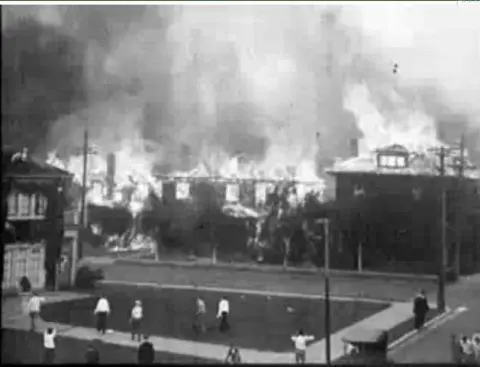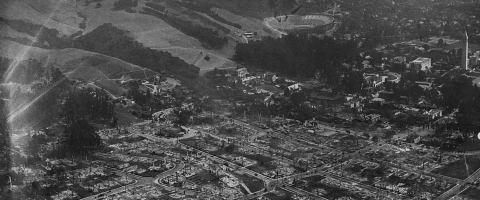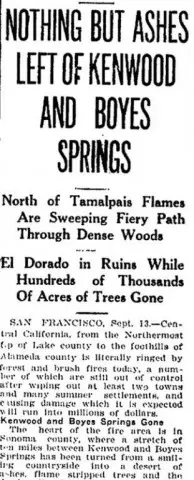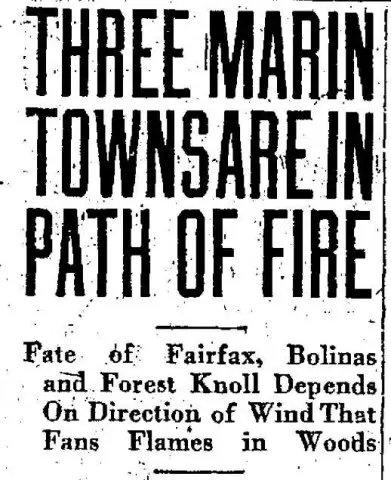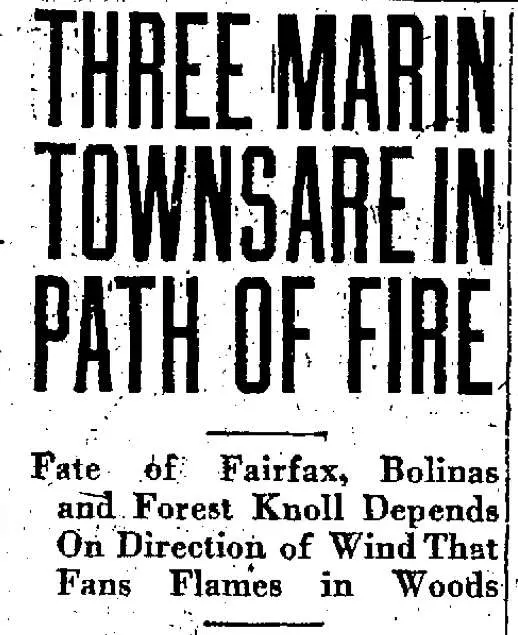
Late in the day on September 17, 1923, a fast moving wildfire started near Novato, burning nearly 50,000 acres and dozens of homes before reaching the Bolinas ridge and the slopes of Mt Tamalpais. Remarkable for the destruction it caused, this remains Marin’s largest historical wildfire and teaches important lessons for current Marin residents.
The wind whipped wildfire occurred during an offshore wind event, known as “Diablo Winds,” (and which would trigger a “Red Flag Warning” today), similar to the Santa Ana winds common in southern California.
Notably, several destructive wildfires burned that day in the Bay Area and northern California, including what would become known as “The Great Fire” in the city of Berkeley, and fires in Nuns Canyon and Calistoga in Napa county, eerily similar to the North Bay fires of 2017. The late season fire weather and low fuel moistures, similar to what we frequently experience in September and October, contributed to a fire siege that gripped much of California, burning Berkeley, Marin, El Dorado, Sonoma, Petaluma, Ukiah, and Santa Barbara. In all, 18 counties saw major fires that day.
From the Sausalito News, Volume XXXVIII, Number 38, September 22, 1923
“Thousands of homes were endangered and many were destroyed, and large areas of timber and grazing land burned over by one of the largest fires that ever took place in this county [Marin], that started at Ignacio last Sunday and swept southerly and is now burning in the vicinity of Lagunitas; estimated damage was easily a quarter of a million dollars. At the same time fires were burning in eighteen counties throughout the state.
The fire started Sunday from smouldering embers fanned by a heavy gale, which spread rapidly and was soon beyond control of the fighters. The embers were left from the fire that was put out after a hard fight, Wednesday, Sept. 12th. The heavy gale whipped it into huge flames that swept down towards Lucas Valley and endangered the county farm. Here, fire fighters congregated and after a long and arduous struggle diverted the fire through the Lucas Valley and saved the [County] farm.
The fire then went through the valley to Woodacre, burning the Hill, Bulltail, Lucchini and Dias ranches. At Woodacre, only five houses out of thirty-five were left standing. All day Monday the fire raged from Woodacre down to the rear of the Sleepy Hollow ranch.
Citizens of the county, students of the Tamalpais Union High School and the San Rafael High School and detachments of soldiers from the Presidio and Fort McDowell were called in to save Fairfax. When the fire reached White’s hill thirty girl patients of the Arequipa Sanitarium were rushed to the Fairfax Community House where they spent Monday night. Monday night the fire was in the Cascades, about a mile and a half from Fairfax, but after hours of hard fighting and backfiring it was halted in the Cascades.
It then started going over the Fairfax ridge and the Bolinas ridge burning everything in its way. Wednesday morning the fire was considered to be under control and the soldiers from Ft. McDowell were sent back. The fire in Lucas Valley around San Geronimo, Lagunitas and Forest Knolls was well under control Wednesday night.
The buildings on the Sleepy Hollow ranch were saved, as well as the buildings on the Bodkin, Pacheco, Lafranchi, Bothin and Dickson ranches. One hundred boys from the San Rafael high school saved the Sleepy Hollow ranch. The traffic officers of the county did excellent work on the roads leading to the fires in the White’s hill district on Monday night. Chief Wessell and Officers Gallaway, Hartwell, Thwing and Constable Nick Yeager kept the roads clear and also assisted in carrying the Arequipa patients to Fairfax.
When the fire was raging on the Bolinas ridge Monday night fifty men from Bolinas headed by men from the United States Life Saving Station went to the ridge and fought fire. Fire Warden Edwin B. Gardner did splendid work in directing the fire fighters. Deputy Fire Warden George Collamore, who was overcome while fighting the fire at Woodacre, is up and around again. At 3 a. m. Wednesday a rootburned tree falling across the concrete 4-foot water main which carries the water supply to all the cities and towns of central Marin, smashed the main, causing a water shortage for several hours. It was repaired by noon Wednesday.”
“As to why these fires, in the forest and in the city, raged so fiercely for a period and subsided so quickly, almost simultaneously, the daily weather maps and the records from the California stations of the Weather Bureau give some very pertinent information. They show the inception, duration, and breaking up of a typical ‘fire-weather’ condition.”
From the “MONTHLY WEATHER REVIEW. SEPTEMBER, 1923 ; “WEATHER AND THE BERKELEY FIRE”, by George M. Alexander; Weather Bureau Office, San Francisco, California, Oct. 15, 1923
Read more at “Marin Fire History”

